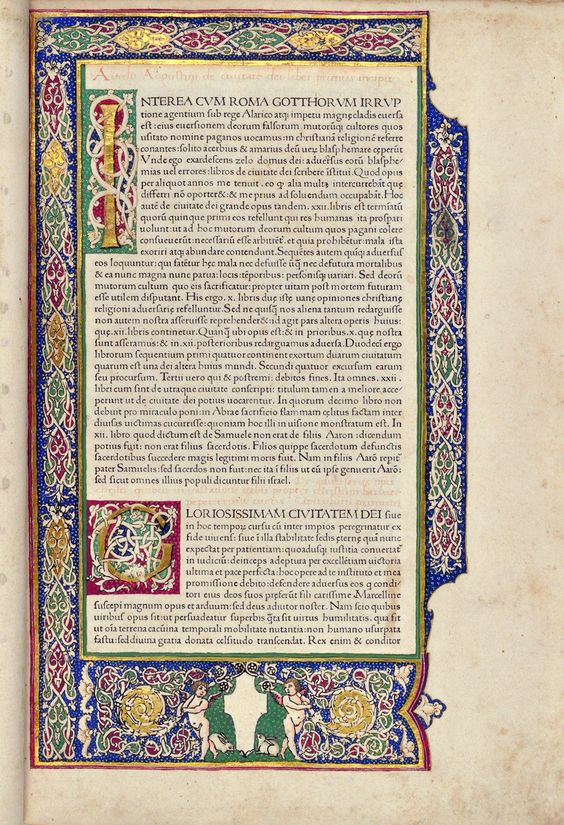AUGUSTINUS, Aurelius (354-430). De civitate Dei. Venice: Johannes and Vindelinus de Spira, 1470.
AUGUSTINUS, Aurelius (354-430). De civitate Dei. Venice: Johannes and Vindelinus de Spira, 1470.
Royal 2° (399 x 280mm). Collation: [1-28 3-2610 278 2810] (1/1 blank, 1/2r rubrics table, 2/8 blank, 3/1r prologue and text, 28/9r colophon, 28/10 blank). 273 leaves (of 274, without blank 2/8). 50 lines, table in two columns. Type: 1:110R. ILLUMINATED BY A CONTEMPORARY MILANESE ARTIST: 14-line initial opening prologue and 21 book initials (space for book 12 initial left blank) in burnished gold with white-vine decoration on blue, green and mauve ground with white dots, first text page with floral multi-colour and gold border sprays, coat-of-arms flanked by initials ‘PA’ and ‘P’ in lower margin, 2-line initials in red, chapter incipits and guide-letters, and headlines giving book numbers in rose ink, a few guide-letters to major initials preserved at extreme fore-margin. (Small wormholes in table, a few small expertly repaired marginal tears, occasional insignificant stain.) Brown morocco tooled in blind, spine lettered in gilt, gilt turn-ins, by Rémy Petit (a few light scuffmarks, short split at upper hinge). Provenance: unidentified contemporary owner, probably from a Lombard or Milanese noble family (arms) — 17th-century collational notes on first and last blanks — [with John Howell, Catalogue 40/3 (1970)].
FIRST VENETIAN EDITION, THE FOURTH BOOK PRINTED AT VENICE, and fourth or fifth edition of De civitate Dei. Johannes de Spira established the first press at Venice in 1469, printing an edition of Cicero’s Epistolae ad familiares in 100 copies. It was followed by a larger (300 copies) reprint of the Cicero, and Pliny’s Historia naturalis. As the colophon to the press’s next production, St. Augustine’s De civitate Dei, famously states, Johannes died suddenly and the edition was completed by his brother Vindelinus, named here for the first time. The colophon also gives valuable evidence for the earlier books, stating that the Pliny was printed in 100 copies within 3 months. Based on the number of other works subsequently printed by Vindelinus in 1470, Geldner argues that his Augustinus appeared early in 1470 and thus pre-dates Sweynheym and Pannartz’s edition printed at Rome the same year (Die deutschen Inkunabeldrucker, pp.62-4). H *2048; GW 2877; BMC V, 153 (IC. 19510); IGI 969; CIBN A-679; Goff A-1233.



